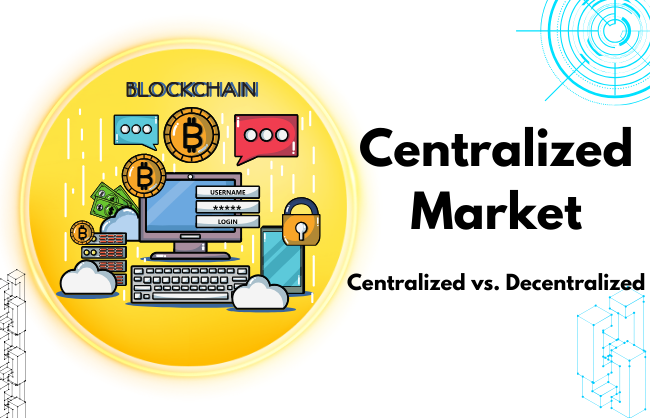2025 Centralized Market:Centralized vs. Decentralized
The financial world is experiencing significant shifts this year. European crypto regulations are changing digital asset trading, economic slowdowns are affecting stock market performance, and global trade tensions are influencing forex markets. As a result of new policies, investment strategies, market liquidity, and financial stability are all evolving globally. These shifts highlight the growing importance of understanding „Centralized market vs decentralized“ by MarketInvestopedia to make informed investment decisions.
Meanwhile, technology is reshaping how markets operate. Artificial intelligence-driven trading is making market predictions more precise, while blockchain adoption is bridging the gap between centralized finance and decentralized innovation. Whether you’re trading forex, stocks, or cryptocurrencies, a thorough understanding of these dynamics is essential. Adapting to regulatory changes and technological advancements—especially in the context of „Centralized market vs decentralized“ will be crucial for navigating the future of global finance.
What is a Centralized Market? Let’s Break It Down
Imagine walking into a massive marketplace where everything is organized, prices are transparent, and there’s a system in place to ensure fair trading. That’s exactly how a centralized market works. It’s a structured financial system where all buying and selling happens through a single, regulated exchange – no confusion, no shady deals, just a well-managed trading environment.
Unlike decentralized markets, where buyers and sellers trade directly without any middleman, centralized markets provide security, stability, and liquidity. This is why they’re the backbone of global finance.

Some Everyday Examples of Centralized Markets:
Stock Exchanges
Think of big names like the NYSE (New York Stock Exchange), DAX (Germany’s stock market), or the London Stock Exchange. These places handle billions in trades every day
Forex Market
The world’s biggest financial market, where currencies are exchanged under the watchful eyes of central banks and regulators.
Commodities Exchanges
Want to trade gold, oil, or wheat? Platforms like Chicago Mercantile Exchange (CME), London Metal Exchange (LME).
Cryptocurrency Exchanges
Platforms like Binance, Coinbase, and Kraken operate as centralized exchanges (CEXs) where users can trade digital assets under regulatory oversight, offering security and liquidity. Unlike fully decentralized exchanges (DEXs), these platforms provide a structured environment similar to traditional financial markets.
Centralized vs. Decentralized Markets – What’s the Difference?
Feature | Centralized Market | Decentralized Market |
Control | Regulated by a single authority (government, exchange, or financial institution). | No central authority users trade directly. |
Transparency | High pricing and transactions are monitored and regulated. | Some platforms offer transparency; others don’t. |
Security | Strongly backed by legal protection and oversight. | Riskier, prone to fraud, hacking, or lack of regulation. |
Liquidity | High lots of buyers and sellers ensure quick transactions. | Can be lown depending on the platform and asset popularity. |
Examples | NYSE (New York Stock Exchange), DAX (Germany), and London Stock Exchange. | Bitcoin, Ethereum, Uniswap (crypto trading). |
What is a Local Market?
Think of a local market as your country’s financial playground—it’s where businesses, investors, and traders come together to buy and sell within a specific region. Unlike global markets that connect the whole world, local markets focus on a country’s economy.
For example, in Germany, the DAX and Frankfurt Stock Exchange are major financial hubs where investors trade stocks of top German companies. These markets reflect how well the country’s economy is doing—when businesses grow, stock prices rise, and when there’s economic trouble, you’ll see some dips.
Simply put, a local market is the heartbeat of a country’s financial system, influencing everything from jobs to investments.
Latest Updates on Centralized Markets in 2025
A lot is happening in the financial world this year From tighter crypto rules to global trade tensions, these shifts are reshaping how markets behave. Here’s what’s making waves:
Event | What’s Happening? | Impact on Markets |
EU Tightens Crypto Regulations (MiCA) | The EU is cracking down on crypto with stricter security and compliance rules. | Investors are feeling cautious some welcome the security boost, while others worry about restrictions. |
Germany’s Economic Growth Slows | Industrial production isn’t picking up as expected. | The stock market is feeling the pressure, with investors holding back on big moves. |
U.S. Tariffs on EU and China | The U.S. is imposing new trade tariffs, shaking up global trade. | Forex markets are going wild as traders rush to safer currencies like USD. |
Mastercard’s Blockchain Expansion | Mastercard is integrating blockchain tech into its financial systems. | A sign that traditional finance is warming up to decentralized technologies big things ahead |
How Do Centralized Markets Actually Work?
Let’s break it down in simple terms centralized markets are like a well-organized shopping mall for trading. Everything happens in one place, under strict rules, so there’s no chaos. Here’s how it works:
- Single Exchange Platform – Imagine a giant marketplace where all trades happen in one regulated space. No back-alley deals just a structured, official setup like the NYSE or DAX.
- Price Transparency – No hidden tricks! The prices of stocks, currencies, and commodities are displayed in real-time, so everyone sees the same numbers. It’s fair, clear, and regulated.
- Regulatory Oversight – Big watchdogs like the SEC (USA), ECB (Europe), and FCA (UK) keep an eye on everything. They make sure traders play by the rules and no one gets scammed.
- High Liquidity – Picture a super-busy food court—you can buy or sell something quickly because there are always people ready to trade. That’s exactly how centralized markets ensure smooth transactions.
In short, centralized markets give traders a safe, structured, and efficient space to invest, without the uncertainty of unregulated trading.
The Good and the Not-So-Good of Centralized Markets
Just like everything in life, centralized markets have their upsides and downsides. Let’s make it simple:
Why Traders Love Centralized Markets:
- Stable Market Conditions – No price swings! Since everything is regulated, prices don’t jump wildly like in crypto.
- High Liquidity – Think of it like a busy supermarket with many buyers and sellers, so you can trade fast without waiting.
- Security & Protection – Rules and regulations keep scams in check and make sure investors don’t get cheated.
The Flip Side – What’s Not So Great?
- Market Manipulation – Big institutions sometimes pull the strings, moving prices in their favor. Small traders? They just have to ride the wave.
- Regulatory Barriers – Not everyone can just jump in and trade. There are strict rules and licenses to follow.
- Limited Accessibility – Some regions have restrictions, meaning that not all investors get a fair chance at trading globally.
What’s Next for Centralized Markets?
The financial world isn’t standing still big changes are coming, and traders need to keep up! Here’s what’s shaping the future:
- AI & Algorithmic Trading – Imagine robots making trades in seconds based on complex data. AI is making markets smarter, faster, and more efficient, reducing human error.
- Blockchain Meets Traditional Finance – Big banks and institutions aren’t ignoring crypto anymore. They’re adopting blockchain to improve transparency, security, and speed in financial transactions.
- More Regulations – Governments worldwide are tightening rules to protect investors and make sure markets stay fair. Expect more compliance checks and stricter trading laws in the coming years.
Conclusion: Why Centralized Markets Still Matter
At the end of the day, centralized markets keep the financial world running smoothly. They provide security, liquidity, and stability, making it easier for investors to trade with confidence. But the game is changing. DeFi (Decentralized Finance) is gaining ground, and we might see a future where both systems blend together.
For traders and investors, the key to success is staying informed. Keep an eye on new regulations, market shifts, and tech advancements like AI and blockchain. The financial world never stops evolving, and those who adapt will always stay ahead.
FAQ
Yes, but only with regulated brokers.
$500-1000 is recommended in order to use leverage effectively.
Capital gains are subject to withholding tax in Germany.
